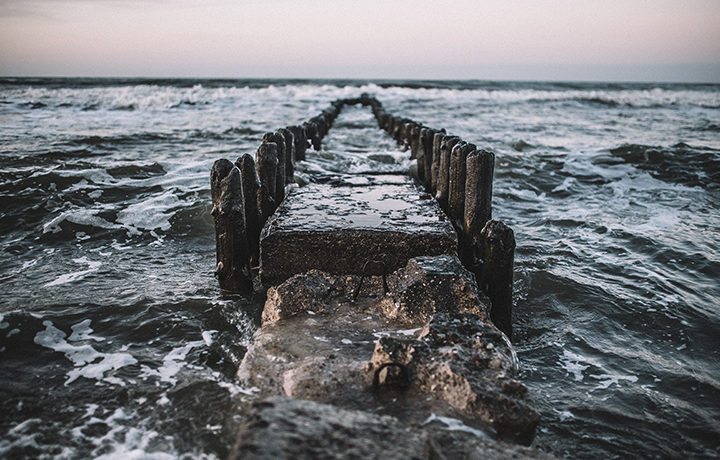Category
- Concrete Waterproofing
To ensure the concrete structure’s service life will not be reduced by the incursion of water, preventative steps must be taken. And the very first step is to understand exactly how water damages concrete.
1. Carbonation
New concrete provides reinforcing steel with excellent corrosion protection. That’s because the presence of free lime (calcium hydroxide) in new concrete creates a highly alkaline environment that causes a “passivating” layer to form around the steel reinforcing bars. This passive layer protects the steel and prevents oxidation and corrosion. Over time, carbonation from atmospheric carbon dioxide (CO2) will convert free lime to calcium carbonate (limestone), progressing until it reaches the depth of the reinforced steel. Carbonated concrete has a lower pH, which breaks down the passivating layer. Once water and oxygen get involved, the iron in the steel oxidizes to iron oxide (rust) which has a greater volume than the original iron. The force of this expansion cracks the concrete, leading to accelerated corrosion and deterioration.
Durable concrete with low permeability slows down the rate of carbonation and prevents water penetration necessary for corrosion to occur.
2. Chloride attack
Three factors lead to corrosion in reinforced concrete: electrolyte for ion transfer (water), conductor for electron transfer (reinforced steel), and oxygen. Eliminating just one of these factors will prevent the corrosion of steel reinforcement. That’s why you will find little to no corrosion in dry concrete. Even in the presence of water and oxygen, the passive layer around reinforcement can protect the steel from oxidation for many years. However, the situation changes completely if chloride ions are present. Chlorides destabilize the passive layer of protection around reinforced steel (rebar). Once stripped of this protective layer, corrosion can begin. Concrete is normally exposed to chlorides through ocean water or road de-icing salts. Chloride ions are not a part of the corrosion processes, but it facilitates the electrochemical process of corrosion which requires an anode (an electron source), a cathode (an electron destination) and a conductive solution, or electrolyte. Chloride ions act to polarize different regions of the metal and increase conductivity.
3. Sulfate attack
Sulfates in solution attack concrete in two ways; either chemically or physically. In solution, it can cause chemical changes to the cement to weaken the bond between the cement paste and the aggregate. That leads to extensive cracking and wear. Sulfate solutions can also cause damage through crystallization and recrystallization within porous concrete leading to expansion and cracking (physical salt attack). Both processes are the result of high-sulfate soils and ground waters but can also be caused by atmospheric or industrial water pollution, or seawater.
 4. Alkali-aggregate reaction (AAR)
4. Alkali-aggregate reaction (AAR)
Certain aggregates can react with the alkali hydroxides in concrete over time to cause a slow deterioration of the concrete through expansion and cracking. This may cause significant damage outright, and the resulting cracking is an invitation for the ingress of water to cause corrosion of the rebar.
There are two forms of alkali-aggregate reaction, Alkali-silica reaction (ASR) and Alkali-carbonate reaction (ACR). ASR is more common as most aggregates contain reactive silica materials while ACR is rare.
In ASR, the silica in aggregates reacts with alkali hydroxide in concrete and forms a gel that swells as it absorbs water in the surrounding cement paste or water that finds its way into the concrete. As the gel absorbs moisture, swelling results in expansive pressure and causes damage. Cracking in areas with a lot of moisture or water is present often indicates ASR is occurring.
5. Freeze/thaw cycles
Freeze/thaw cycles can cause deterioration to non-air entrained concrete. Frozen water occupies 9% more volume than liquid water. If there is no space in the concrete to allow for the expansion, it will distress concrete and cause hairline cracks. Each thaw allows more water to penetrate through the cracks and each freeze/thaw cycle increase the number and size of hairline cracks resulting in greater damage.
Signs of freeze/thaw damage include spalling and scaling of the concrete surface, surface parallel cracking, or exposed aggregate.
Reducing permeability of concrete prevents the movement of water and the penetration of the harmful chemicals into the concrete.
Preventing water’s incursion into concrete structures limits and even eliminates damage from corrosion, freezing and other water caused effects. With full knowledge about how these processes work, the next step is to find the best methods and products to create dry and durable concrete.





 4. Alkali-aggregate reaction (AAR)
4. Alkali-aggregate reaction (AAR)


